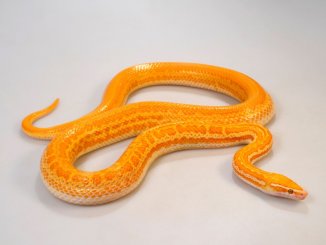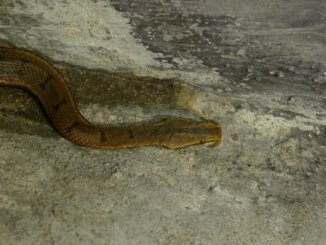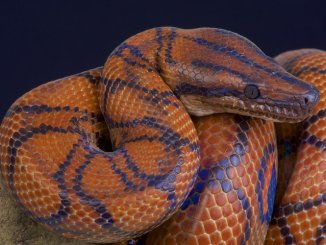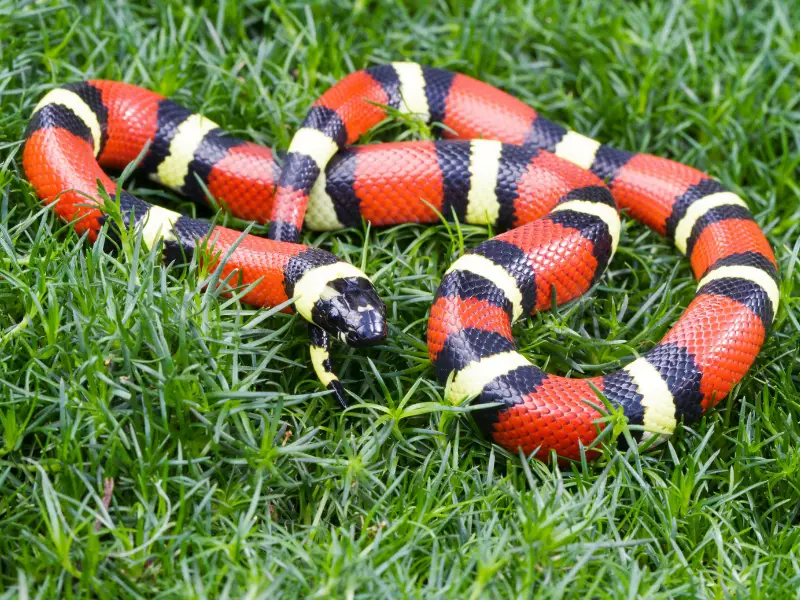
The Pueblan milk snake is a colorful and popular snake to keep in captivity.
These snakes originate from central Mexico and are easily recognizable by their bright red, white, and black bands. They are non-venomous and are relatively easy to find, care for, feed, and handle. With the right care, they should live a long and healthy life.
Pueblan milk snakes are also relatively small, with slender bodies. This means they can thrive without needing an enormous enclosure. They are non-venomous, and owners can comfortably handle them with minimal risks of biting.
This guide provides all the information you need to know about caring for a Pueblan milk snake.
Pueblan Milk Snake Overview
| Common name | Pueblan milk snake, Campbell’s milk snake |
| Scientific name | Lampropeltis Triangulum Campbelli |
| Natural habitat | Southern Puebla, Eastern Morelos, and Northern Oaxaca in Mexico |
| Adult size | 3 - 4 ft (females can be up to 6 feet) |
| Average lifespan | 12 to 22 years |
| Diet | Mice, rats, birds, frogs, lizards, and other snakes |
| Housing | A 40-gallon terrarium |
| Experience | Beginner |
Origin
The Pueblan milk snake (Lampropeltis Triangulum Campbelli) is a non-venomous snake that originates from central Mexico. The snake is typically found in the regions of Southern Puebla, Eastern Morelos, and Northern Oaxaca.
The natural habitat for these snakes is dry, arid desert regions. However, the milk snake can thrive in a wide range of habitats. They are also often found in rocky prairies and forested areas.
Pueblan milk snakes are relatively commonly found in their natural environment. They are also very popular snakes for keeping in captivity, thanks to their vivid coloring and the fact that they are non-venomous.
Appearance And Behavior
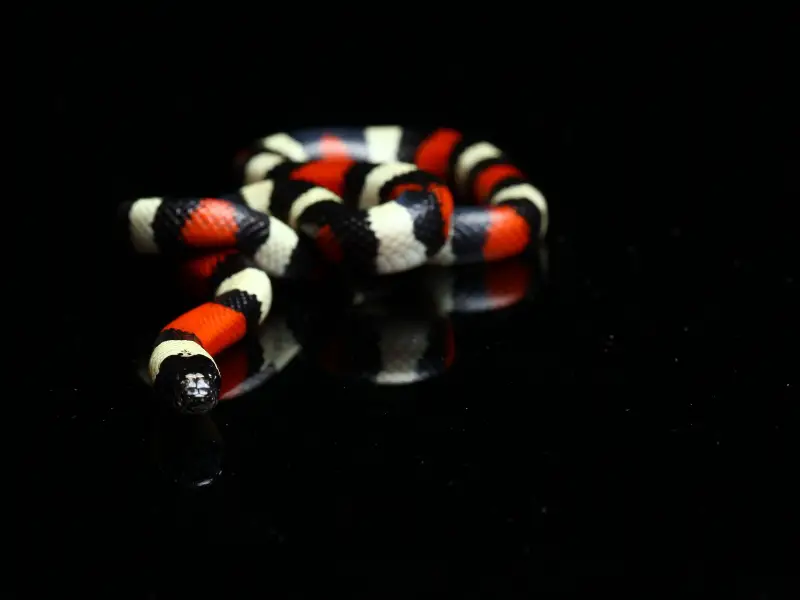
Because of its bright tri-colored striped pattern, you can quickly identify a Pueblan milk snake.
Although these snakes can come in a range of different color patterns, they typically display bright red, white, and black bands across the length of its body.
These color bands mimic the look of the venomous coral snake to scare off predators. This mimicry is known as Batesian mimicry.
It’s possible to confuse Pueblan milk snakes with a tricolor hognose or a Honduran milk snake due to their similar color patterns. However, Pueblan milk snakes are distinguishable from similar-looking subspecies due to their wider white bands and black tipping over their red bands.
These snakes also have particularly vibrant and bright red bands compared to other colorful snakes.
Non-morph Pueblan milk snakes have pure white coloration and include some black speckling on their light bands.
Pueblan milk snakes are slender-bodied with a sock head. Females are usually larger than males.
Size And Lifespan
The average size of an adult Pueblan milk snake is typically around 36 to 48 inches (3 – 4 feet).
This relatively short and slender size is one of the reasons that makes the snake so highly sought after for captivity. Female Pueblan milk snakes are larger than males and can reach lengths of 6 feet.
These snakes typically live for around 12 to 20 years in the wild and up to approximately 22 years in captivity. Pueblan milk snakes are relatively easy to look after.
So you should expect a decent lifespan from one if you keep it in captivity. This long lifespan means new pet owners should be ready for a long-term commitment.
Temperament
Pueblan milk snakes are very docile. They spend a lot of time curled up or hiding. Although they are commonly found in the wild, they are rarely seen because they typically hide away and are most active during dawn and dusk.
The Pueblan milk snake can also be quite a skittish snake, nervous of humans. However, this is primarily when they’re juveniles. As these snakes get older, they become more confident.
While Pueblan milk snakes are very tolerant towards their owners, they don’t do well with other snakes.
Milk snakes hunt and eat other snakes, so cannibalism becomes a real risk if you house two of these snakes together. This is especially true with two male snakes, which will probably result in fighting.
Keeping two male milk snakes together will also definitely result in dominant fighting during the mating season. Milk snakes kept together can also quickly become stressed, as they feel they must compete for food. So it’s best to house your pet snakes individually.
Pueblan milk snakes are easy to handle. They may be hyperactive when held as young snakes, but they calm down over time.
You will need to handle them regularly in short periods to help them get used to being handled. These snakes will rarely bite their handlers.
Housing Pueblan Milk Snakes
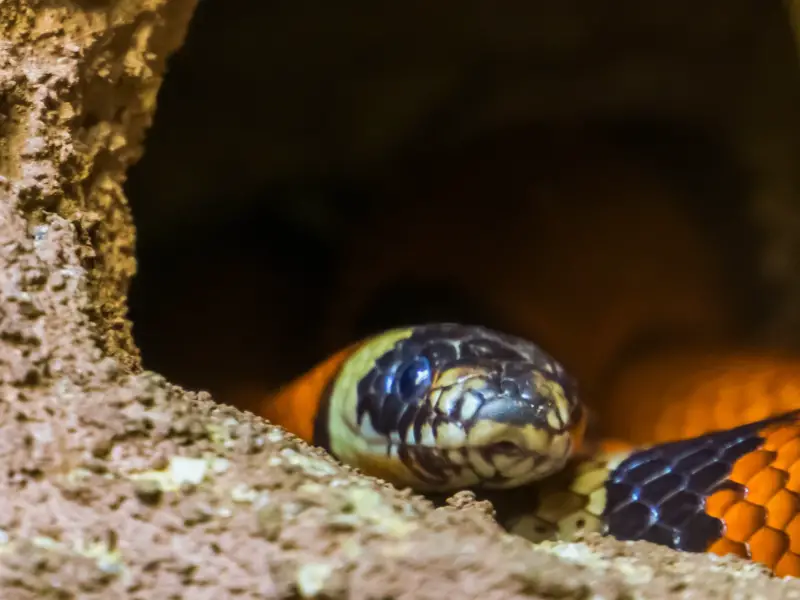
Pueblan milk snakes originate from dry, arid, warm regions in central Mexico. You’ll want to try to recreate similar conditions when housing a Pueblan milk snake.
However, these snakes also thrive in various climatic conditions, from forests to deserts. This makes it relatively straightforward to set up unique housing and care for these snakes.
Enclosure Size
Because Pueblan milk snakes are relatively small, you can use a standard-sized terrarium to house them. A 40 to 60-gallon tank is large enough for a single milk snake.
Some snake owners prefer glass aquariums, while others prefer vivariums. Both options work well for these milk snakes. Terrariums with three wooden sides offer the best insulation.
Your enclosure must be longer than the snake’s length and should have a height of around 17 inches.
It’s a good idea to house hatchlings in smaller tanks, as a large tank can easily stress them out. Baby milk snake tanks should be about 12 inches long and 6 inches tall.
Lighting
It would be best if you used lighting to maintain the day/night light cycle for Pueblan milk snakes. You can use incandescent lights on the enclosure for 12 hours per day.
It is not advisable to rely on lighting as the primary heat source for these snakes, as the lights must be off at night.
You can use a night-time reptile heat light or a ceramic heater in a Pueblan milk snake’s enclosure to maintain warmth. Regular incandescent lamps are ideal to use during the day.
A UVB lamp is not entirely necessary for Pueblan milk snakes as they are nocturnal. However, exposure to UVB is beneficial so we recommend installing a UVB lamp with a low UV intensity.
Temperature And Humidity
Pueblan milk snakes come from a warm and dry climate, so owners should recreate these conditions in the enclosure. Aim to maintain the temperature in the enclosure between 76°F to 86°F.
As is the case when keeping any reptile, you’ll need a warm and cool side of the enclosure to help them thermoregulate.
Use a heating pad on one-third of the tank to generate this heat. The snake will regulate its body temperature by moving between the warmer and cooler areas of the tank.
Pueblan milk snakes thrive in relatively low humidity levels. The humidity should be between 40% and 60%. If you do not manage the humidity properly, it could cause skin issues.
Proper humidity also helps the snake shed its skin comfortably.
If the humidity is too low, add a ceramic bowl of water over the heated part of the terrarium. You could also mist the terrarium. Use a hygrometer to monitor the enclosure’s humidity levels closely.
Substrate And Decoration
Choosing the substrate for your Pueblan milk snake enclosure is pretty simple. It depends on what kind of substrate you prefer the look of and what is more convenient for you to clean. You could use newspaper, paper towel, ashen, or butcher paper.
Coconut fiber bedding for reptiles is ideal for laying on top of this. Beechwood chips also work well. Creative owners could also use soil and clay to recreate the snake’s natural environment.
Always avoid cedar bedding for milk snakes, as this can be toxic to the snake’s skin. Gravel, rock, and sand bedding could also irritate the snake’s skin, so pet owners should avoid these materials too.
Pueblan milk snakes are often found on rocky slopes of open prairies or in forested areas. This means you can include various types of rocks or foliage in the enclosure.
Pueblan milk snakes prefer well-decorated environments. Natural slate rocks are always a great addition, as these hold onto heat and can help the snake gain underbelly warmth.
You can incorporate tall plants, cork wood pieces, and caves to enhance the enclosure and give the snake shelter from the light.
Make sure to add two spacious hides into the enclosure – one on each end in the different temperature zones.
Cleaning
As with keeping any snake, regularly cleaning your Pueblan milk snake’s enclosure is essential. Spot clean the enclosure daily to get rid of any feces and to replace the snake’s dirty water. Doing this is necessary for preventing the spread of bacteria in the enclosure.
You’ll also need to deep-clean the enclosure once a month. To do this:
- Remove the milk snake from the enclosure and remove every decoration from the tank.
- Scrub it all with hot soapy water, or use a reptile-friendly disinfectant.
- Ensure you scrub every surface to get rid of any bacteria.
During cleaning, you may place your milk snake in a container, such as a deep tub. Ensure the container has ventilation holes and a lid. After cleaning, gently place the snake back in its enclosure.
Pueblan Milk Snake Care
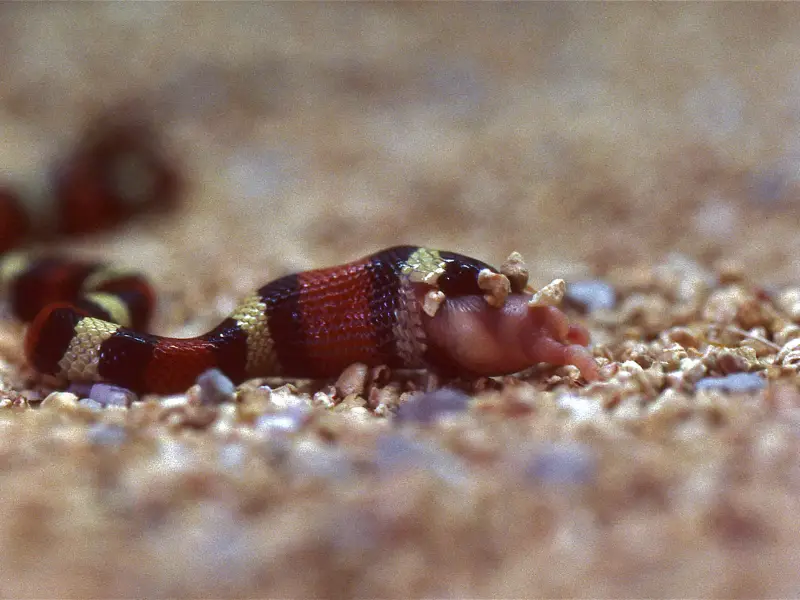
Caring for a Pueblan milk snake is relatively straightforward, which is why these snakes are great for first-time owners.
As long as you keep the enclosure clean and heated to the right temperature and feed the snake regularly, you should be able to enjoy a long and healthy lifespan from these milk snakes.
Food And Water
Pueblan milk snakes are opportunistic eaters in the wild, which means they eat practically any creature. They have been known to eat rats, mice, small birds, lizards, frogs, and other snakes. This makes the species very easy to feed.
Feeding a captive Pueblan milk snake is best done with thawed frozen mice. Adult snakes will eat mice once every week, or the second week, while juveniles will eat small pinkies every week.
Start these snakes with small pinkies when they’re juveniles, and work them up to full-sized mice as they grow.
Ensure that you feed these snakes appropriately sized mice. This should be a mouse around one and a half times the thickness of the snake’s girthiest section.
Pueblan milk snakes are relatively slender and you’ll want to avoid letting adult snakes gain too much weight. If they do, cut back on the feeding.
Handling
Handling Pueblan milk snakes is pretty straightforward. It might be tricky at first, but once the snake gets used to human touch, it can be comfortably and regularly handled.
Juvenile Pueblan milk snakes are skittish and will be very hyperactive when you first handle them. As the snake gets older, it will relax more during handling.
It’s crucial to handle these snakes in short but regular intervals. Don’t handle the snake for longer than around 15 minutes.
Always avoid handling directly after feeding the snake, as this will cause too much stress. Snakes should wait at least 24 hours after a feed before being handled.
If you handle them after feeding they may become stressed and regurgitate their food.
Another interesting fact to keep in mind is that Pueblan milk snakes can discharge a strong-smelling exudate from their cloaca when handled.
This is used as a defense mechanism and is more common for young snakes without much handling experience.
Common Health Issues
Pueblan milk snakes don’t have any species-specific health issues that affect them. They are, however, susceptible to all of the common health issues that could affect snakes in captivity.
Common health issues include parasites and bacterial or fungal infections. Infections could result from a dirty habitat, which generally affects the snake as a respiratory infection.
Regularly cleaning the snake’s enclosure is the best way to avoid these issues.
The snake can also develop respiratory infections if you do not maintain the correct humidity levels. This causes inflammation in the snake’s nostrils and mouth, and it will need antibiotics.
Before taking a new snake home, it’s always a good idea to check the snake for any possible parasites or bacteria. You can do this using a stool sample.
Pueblan milk snakes are commonly bred, so using a reputable breeder can help you avoid these health issues.
Breeding
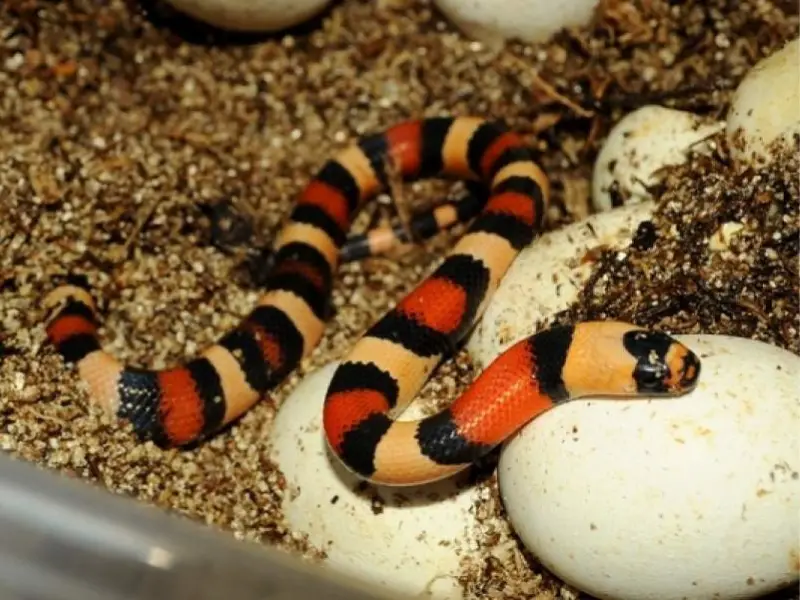
Before breeding Pueblan milk snakes, ensure you have a healthy adult pair. Adults should be full-sized and without any health problems.
Otherwise, the adults can pass their health issues down through breeding. You will also need to be prepared to house and feed all hatchlings separately.
When To Breed
Pueblan milk snakes naturally breed in the Spring when the weather improves, as this is the ideal time for the snake’s eggs to hatch.
Stop feeding the snake about two weeks before brumation to ensure its digestive tract is empty. This would be around October.
You’ll want to maintain a slightly lower and constant temperature in November. Your goal is to show a seasonal change to the snake, which makes them realize its breeding season.
You can brumate for around six weeks to three months. Feed the female to ensure she’s ready for breeding.
The Breeding Process
The female gives off potent pheromones, so introduce the male into the female’s enclosure. Pheromones will be strongest if the female has recently shed.
Supervising these snakes when introducing them into new enclosures is always a good idea, as they have cannibalistic tendencies. The male might bite the female. This bite won’t cause any severe damage but could break the skin.
Copulation will take several hours, and the snakes should be left alone. Separate the snakes after copulation. You can repeat this process several times to ensure the female snake is gravid.
Laying Eggs
Before laying eggs, the female will shed her skin after about four weeks since mating. A week after shedding, she will start to look for the right place to lay her eggs.
She will then lay her eggs after a week finding the perfect nesting spot. It takes about six weeks from copulation to egg laying.
Include a large enough egg-laying box for the female. This egg-laying box should include a lot of slightly damp moss, with a layer of vermiculite at the bottom.
The eggs will hatch after 60 to 75 days of incubation at 78°F to 80°F.
Baby snakes will shed in their first week and should be fed a diet of small pinkies straight from birth. House the hatchlings separately, or they may try to eat each other.
Choosing And Buying A Pueblan Milk Snake
Pueblan milk snakes are pretty common snakes, so they are readily available. Always buy these snakes from a reputable breeder to avoid the risks of bacteria and poor breeding.
Pueblan milk snakes are often sold for around $150. When choosing one, pay attention to the snake’s coloring. The coloring should be bright, vivid, and healthy.
Also, pay attention to any possible inflammations in the mouth or nostrils, as this could point to an infection.
As with any snake, it’s always a good idea to test the snake for bacteria before taking it home. You might want to leave the snake in a quarantine enclosure before introducing it into its permanent enclosure.

